A Novel Fault Early Warning Model Based on Fault Gene Table for Smart Distribution Grids
Abstract
:1. Introduction
2. Design of the Fault Gene Table
2.1. State Division of Smart Distribution Grids
2.2. Operational State Evaluation of Each Bus
2.3. Operational State Evaluation Model of Smart Distribution Grid
2.4. Fault Gene Table Construction Procedure of Smart Distribution Grid
- A k-means clustering is adopted to cluster all buses state goals of the smart distribution grid in historical fault data source into four classes, labeled with related tags including of E, G, M and B according to the magnitude of average state goal calculated by Equation (5).where denotes to different class, m is the number of buses, represents the number of groups in class, and represents the state goal of smart distribution grid in the mth bus of the zth group.
- One part of the clustered data is regarded as the training sample matrix shown as Equation (6).where n is the number of training samples, and state goal in the mth bus of the nth training sample.
- The other part of the clustered data is regarded as evaluation matrix , which is shown as Equation (7).where n∗ is the number of evaluation samples, and represents state goal in the mth bus of the evaluation sample.The training sample matrix is input into the BP neural network to determine the weights and thresholds, and the training process was as follows:
- Set the weight and threshold between input layer and hidden layer are respectively and , the weight and threshold between hidden layer and output layer are respectively and , the number of nodes in hidden layer is N, learning rate is , and the expected output of state goal is which is chosen distinct value according to the type of input sample Specifically, the for Bad(B) can be a reasonable value between 0 and 0.25, the for Middle(M) can be a reasonable value between 0.25 and 0.5, the for Good(G) can be a reasonable value between 0.5 and 0.75, and the for Excellent(E) can be a reasonable value between 0.75 and 1. For example, these expected outputs of state goals can take the mean value of the range, namely 0.125, 0.375, 0.625 and 0.875 respectively.
- Choose sigmoid function as the activation function of hidden layer and output layer, namely and , which is shown as Equation (8).
- Calculate the input and output value of each hidden neuron, which is shown as Equation (9)where is the input value of each hidden neuron, is the output value of each hidden neuron, , which denotes the index of training sample, and state goal in the ith bus of the rth training sample.
- Calculate the output value y according to the output of hidden layer , weight and threshold between hidden layer and output layer and , which is shown as Equation (10).
- Calculate the output error according to Equation (11).
- Calculate the generalization error of output layer by Equation (12).
- Calculate the generalization error of hidden layer by Equation (13).
- Adjust the weight and threshold between hidden layer and output layer and , which is calculated as Equation (14).where and are the weight and threshold between hidden layer and output layer after adjustment.
- Adjust the weight and threshold between input layer and hidden layer and , which is calculated as Equation (15).where and are the weight and threshold between input layer and hidden layer after adjustment.
- When is changed from 1 to n, all training sample is trained completely, the global error will be calculated by adding all errors of each training sample. If reaches into the specified error range, return to the step k, otherwise, set the to zero and return to step c to repeat the training.
- End the training and record the weights and thresholds of current network.
- Input the evaluation matrix into the trained BP neural network to get the state goal of the smart grid at each moment, and then compare it with the expected state to verify the effectiveness of the model. The trained BP neural network will be used to build the mapping relationship between state transition time sequence and fault so as to construct the fault gene table. The construction flow chart of fault gene table for the smart distribution grid is shown as Figure 2. The constructed fault gene table is shown as Figure 3.
3. Fault Early Warning by Improved Smith–Waterman
3.1. Improved Smith–Waterman
- Fill in the dynamic programming matrix.
- Find the maximal score in the matrix.
- Trace back the path that leads to the maximal score to find the optimal local alignment.
- If two states are matched, the worse the performances of two states are, the higher the match score is; namely, the match score of E with E, G with G, M with M and B with B follow an ascending order.
- If two states are mismatched, the bigger the difference between the two states is, the lower the match score. For instance, the match score of E with G, E with M and E with B follows a descending order.
3.2. Procedure of Fault Early Warning by Improved Simth–Waterman
- The operation data of a smart distribution grid is obtained periodically in real time, and transformed to state transition time sequence, namely gene to be matched, by the BP neural network. The length of it gradually increases with the passage of time.
- The gene to be matched and the gene in fault gene table are matched periodically by the improved Smith–Waterman algorithm, and the matching process is as follows:
- Let gene to be matched , gene in fault gene table , and the lengths of them be and , respectively.
- Determine the substitution matrix and the gap penalty scheme.
- Construct a scoring matrix D and initialize its first row and first column. The size of the scoring matrix is (.
- Fill the scoring matrix using the Equations (17) and (18).In which, , , can be calculated by Equation (16), and are the gap penalty when the or the is dash.
- Find and to makewhere is the highest score in the scoring matrix D.
- Until all alignments are finished between genes to be matched and all genes in the fault gene table, all highest scores are obtained.
- Find the maximum score from all the highest scores, and compare it to the given threshold. If the maximum score exceeds the threshold, the related fault will be warned early. The block diagram of fault early warning for smart distribution grid realized by the improved Smith–Waterman algorithm is shown as Figure 4.
4. Simulation and Analysis
4.1. Simulation Parameters
4.2. Procedure of Simulation
4.2.1. Simulation of Fault Gene Table Construction
4.2.2. Simulation of Fault Early Warning
- In terms of weights: the accuracy rate of fault early warning is higher when the weights of voltage and reactive power of each bus is bigger. The threshold has a trend of decreasing at the maximum accuracy rate of fault early warning with the decrease of voltage weight.
- In terms of threshold: when the threshold is too small, the probability of error is higher due to the interference of the other similar fault genes. While the threshold is too large, the probability of that fault occurring before the match score reaches the threshold is higher.
5. Conclusions
Acknowledgments
Author Contributions
Conflicts of Interest
References
- Ardito, L.; Procaccianti, G.; Menga, G.; Morisio, M. Smart Grid Technologies in Europe: An Overview. Energies 2013, 6, 251–281. [Google Scholar] [CrossRef]
- Chu, C.C.; Lu, H.C. Complex Networks Theory for Modern Smart Grid Application: A Survey. IEEE J. Emerg. Sel. Top. Circ. Syst. 2017, 7, 177–191. [Google Scholar] [CrossRef]
- Mahdad, B.; Srairi, K. Blackout risk prevention in a smart grid based flexible optimal strategy using Grey Wolf-pattern search algorithms. Energy Convers. Manag. 2015, 98, 411–429. [Google Scholar] [CrossRef]
- Andrén, F.P.; Strasser, T.I.; Kastner, W. Engineering Smart Grids: Applying Model-Driven Development from Use Case Design to Deployment. Energies 2017, 10, 374. [Google Scholar] [CrossRef]
- Fang, X.; Misra, S.; Xue, G.; Yang, D. Smart Grid-The New and Improved Power Grid: A Survey. IEEE Commun. Surv. Tutor. 2012, 14, 944–980. [Google Scholar] [CrossRef]
- Missaoui, R.; Warkozek, G.; Bacha, S.; Ploix, S. Real Time Validation of an Optimization Building Energy Management Strategy Based on Power-Hardware-in-the-loop Tool. In Proceedings of the IEEE PES International Conference and Exhibition on Innovative Smart Grid Technologies, Berlin, Germany, 14–17 October 2012; pp. 1–7. [Google Scholar]
- Ciabattoni, L.; Comodi, G.; Ferracuti, F.; Fonti, A.; Giantomassi, A.; Longhi, S. Multi-apartment residential microgrid monitoring system based on kernel canonical variate analysis. Neurocomputing 2015, 170, 306–317. [Google Scholar] [CrossRef]
- Lu, Y.; Liu, D.; Liu, J. Information Integration Demand and Model Analysis for Smart Distribution Grid. Autom. Electr. Power Syst. 2010, 34, 1–4. [Google Scholar]
- Li, T.; Xu, B. Self-healing and its benchmarking of smart distribution grid. Power Syst. Prot. Control 2010, 38, 105–108. [Google Scholar]
- Wang, C.; Grebogi, C.; Baptista, M.S. Control and prediction for blackouts caused by frequency collapse in smart grids. Chaos 2016, 26, 22–29. [Google Scholar] [CrossRef] [PubMed]
- Jia, Y.; Xu, Z.; Lai, L.L.; Wong, K.P. Risk-based power system security analysis considering cascading outages. IEEE Trans. Ind. Inform. 2016, 12, 872–882. [Google Scholar] [CrossRef]
- Lu, B.; Li, Y.; Wu, X.; Yang, Z. A Review of Recent Advances in Wind Turbine Condition Monitoring and Fault Diagnosis. In Proceedings of the 2009 IEEE Power Electornics and Machines in Wind Applications, Lincoln, NE, USA, 24–26 June 2009; pp. 1–7. [Google Scholar]
- Zhong, Q.; Zhang, W.; YU, H.; Li, L.; Wang, L. Research on harmonic forecasting and warning of active distribution network. Power Syst. Prot. Control 2014, 42, 50–56. [Google Scholar]
- Chen, P.C.; Kezunovic, M. Fuzzy Logic Approach to Predictive Risk Analysis in Distribution Outage Management. IEEE Trans. Smart Grid 2016, 7, 2827–2836. [Google Scholar] [CrossRef]
- Nemati, H.M.; Sant’Anna, A.; Nowaczyk, S. Bayesian Network representation of meaningful patterns in electricity distribution grids. In Proceedings of the 2016 IEEE International Energy Conference (ENERGYCON), Leuven, Belgium, 4–8 April 2016; pp. 1–6. [Google Scholar]
- Li-an, C. Prediction for Magnitude of Short Circuit Current in Power Distribution System Based on ANN. In Proceedings of the 2011 International Symposium on Computer Science and Society, Kota Kinabalu, Malaysia, 16–17 July 2011; pp. 130–133. [Google Scholar]
- Shi, S.; Wang, K.; Chen, L. Power transformer status evaluation and warning based on fuzzy comprehensive evaluation and Bayes discrimination. Electr. Power Autom. Equip. 2016, 36, 60–66. [Google Scholar]
- Tong, C.; Gao, Y.; Wang, Q. Coordination of Dynamic Lightning Protection and Smart Grids State Estimation. In Proceedings of the 2014 International Conference on Lightning Protection (ICLP), Shanghai, China, 11–18 October 2014; pp. 1027–1035. [Google Scholar]
- Zhen, C.; Hou, J.; Yan, J. Functional Design and Implementation of Online Dynamic Security Assessment and Early Warning System. Power Syst. Technol. 2010, 34, 55–60. [Google Scholar]
- Jiang, H.; Zhang, J.J.; Gao, W.; Wu, Z. Fault Detection, Identification, and Location in Smart Grid Based on Data-Driven Computation Methods. IEEE Trans. Smart Grid 2014, 5, 2947–2956. [Google Scholar] [CrossRef]
- Chertkov, M.; Pan, F.; Stepanov, M.G. Predicting Failures in Power Grids: The Case of Static Overloads. IEEE Trans. Smart Grid 2010, 2, 162–172. [Google Scholar] [CrossRef]
- Vaiman, M.; Vaiman, M.; Maslennikov, S.; Litvinov, E.; Luo, X. Calculation and Visualization of Power System Stability Margin Based on PMU Measurements. In Proceedings of the First IEEE International Conference on Smart Grid Communications, Gaithersburg, MD, USA, 4–6 October 2010; pp. 31–36. [Google Scholar]
- Costantino, N.; Serventi, R.; Tinfena, F.; D’Abramo, P.; Chassard, P.; Tisserand, P.; Saponara, S.; Fanucci, L. Design and Test of an HV-CMOS Intelligent Power Switch With Integrated Protections and Self-Diagnostic for Harsh Automotive Applications. IEEE Trans. Ind. Electron. 2011, 58, 2715–2727. [Google Scholar] [CrossRef]
- Saponara, S.; Fanucci, L.; Bernardo, F.; Falciani, A. Predictive Diagnosis of High-Power Transformer Faults by Networking Vibration Measuring Nodes with Integrated Signal Processing. IEEE Trans. Instrum. Meas. 2016, 65, 1749–1760. [Google Scholar] [CrossRef]
- Conley, J.M.; Mitchell, R.; Cadigan, R.J. A Trade Secret Model for Genomic Biobanking. J. Law Med. Ethics 2012, 40, 612–629. [Google Scholar] [CrossRef] [PubMed]
- Chen, X.; Gu, X.; Xu, K. Architecture for Self-healing Control of Urban Power Grid. Autom. Electr. Power Syst. 2009, 33, 38–42. [Google Scholar]
- Jia, D.; Meng, X.; Song, X. Technology Framework of Self-Healing Control in Smart Distribution Grid. Power Syst. Clean Energy 2011, 27, 14–18. [Google Scholar]
- Huang, L.T.; Wu, C.C.; Lai, L.F.; Li, Y.J. Improving the mapping of smith-waterman sequence database searches onto CUDA-Enabled GPUs. BioMed Res. Int. 2015, 2015, 185179. [Google Scholar] [CrossRef] [PubMed]
- Okada, D.; Ino, F.; Hagihara, K. Accelerating the smith-waterman algorithm with interpair pruning and band optimization for the all-pairs comparison of base sequences. BMC Bioinform. 2015, 16, 321. [Google Scholar] [CrossRef] [PubMed]
- Laurens, V.D.M. Accelerating t-SNE using tree-based algorithms. J. Mach. Learn. Res. 2014, 15, 3221–3245. [Google Scholar]
- Laurens, V.D.M.; Hinton, G.; Hinton, V.D.M.G. Visualizing Data using t-SNE. J. Mach. Learn. Res. 2008, 9, 2579–2605. [Google Scholar]
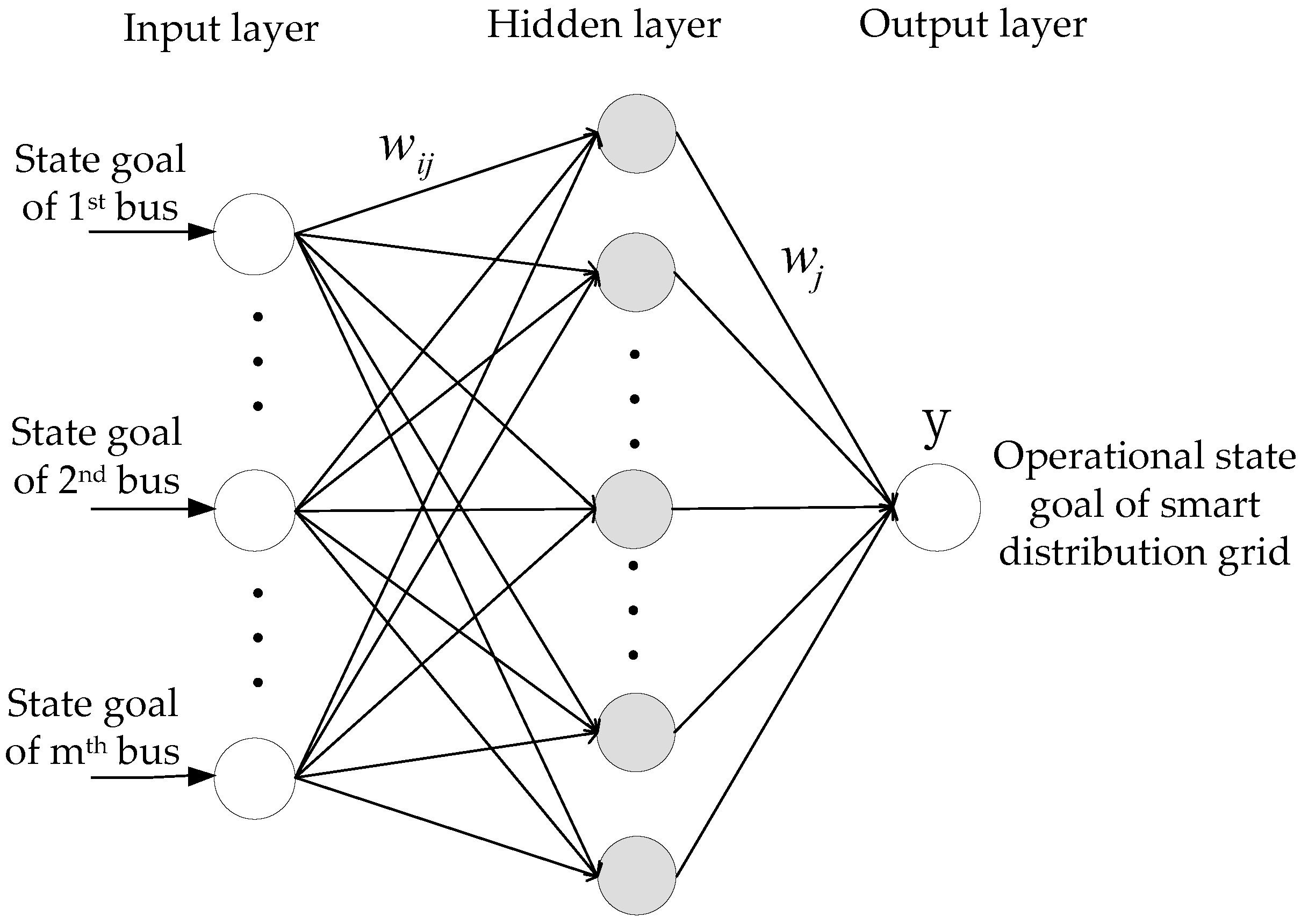
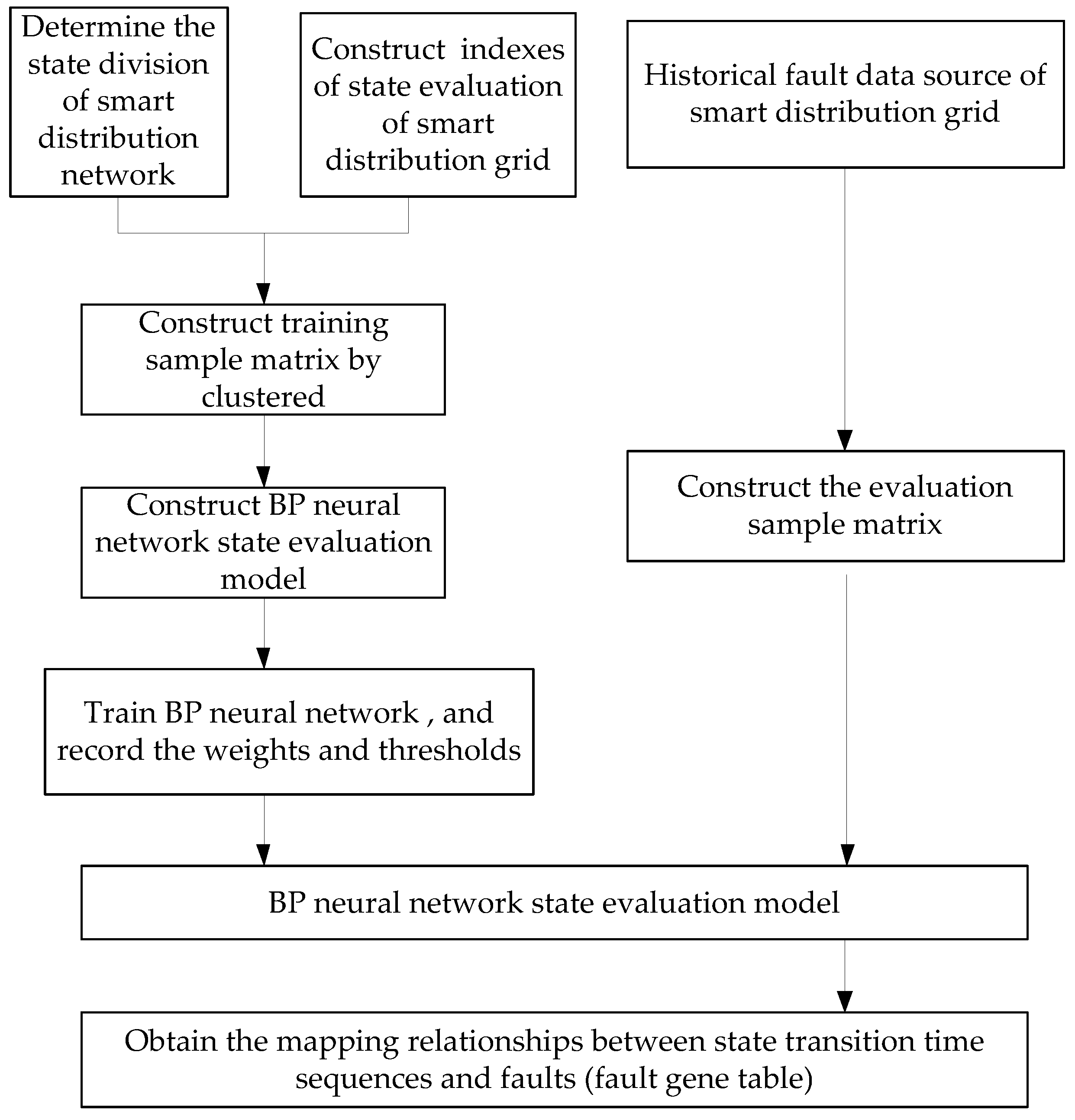
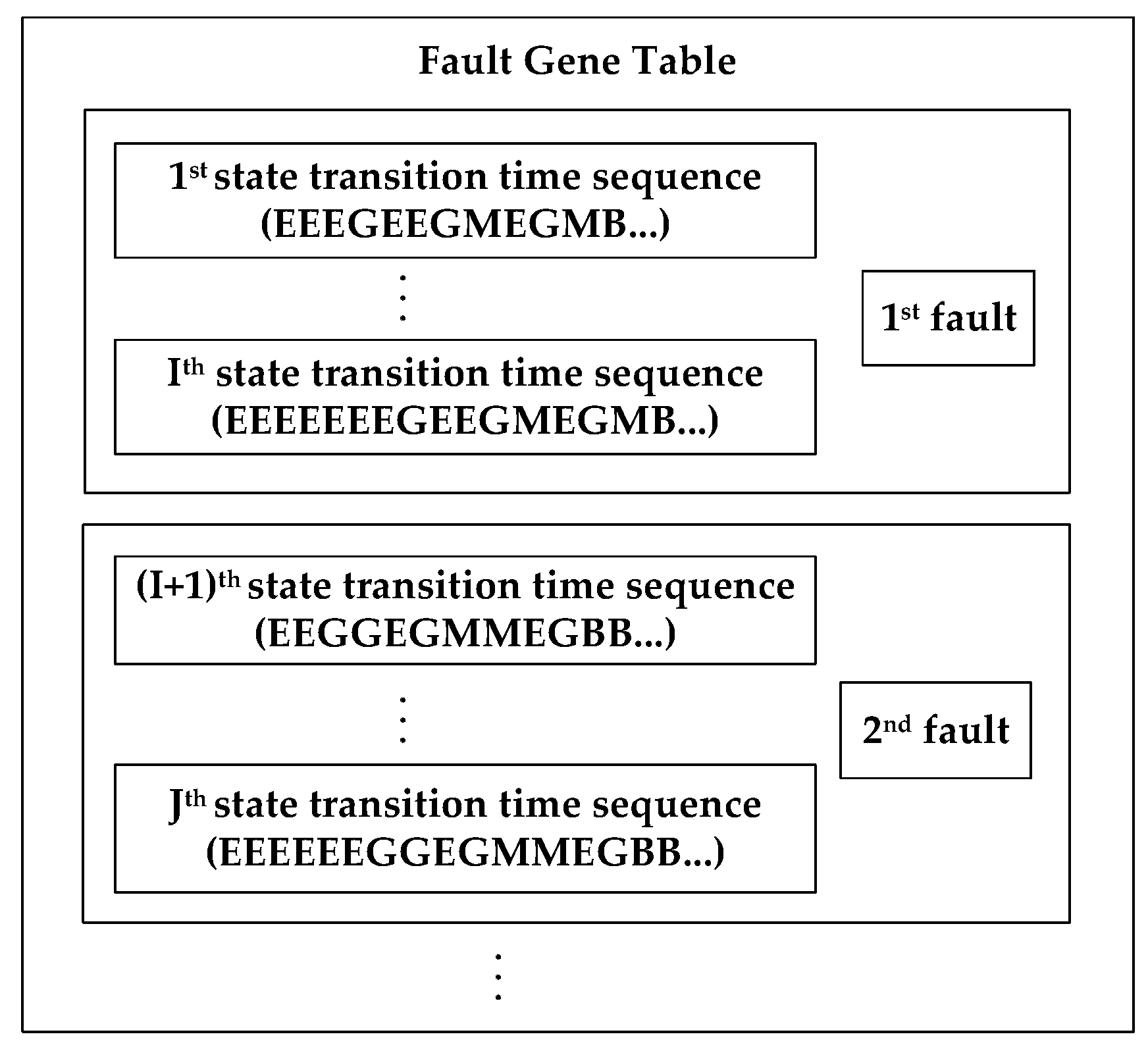

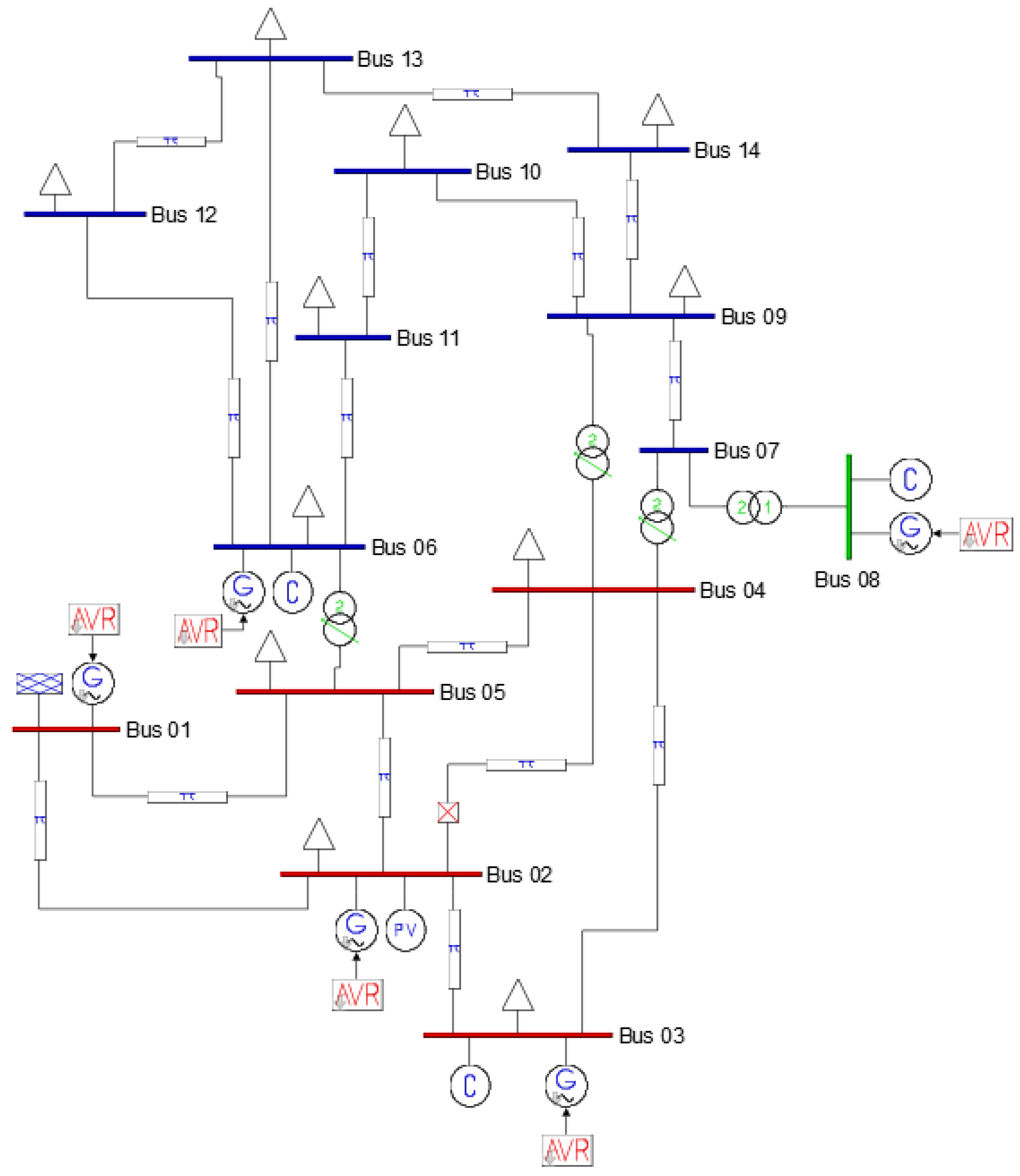
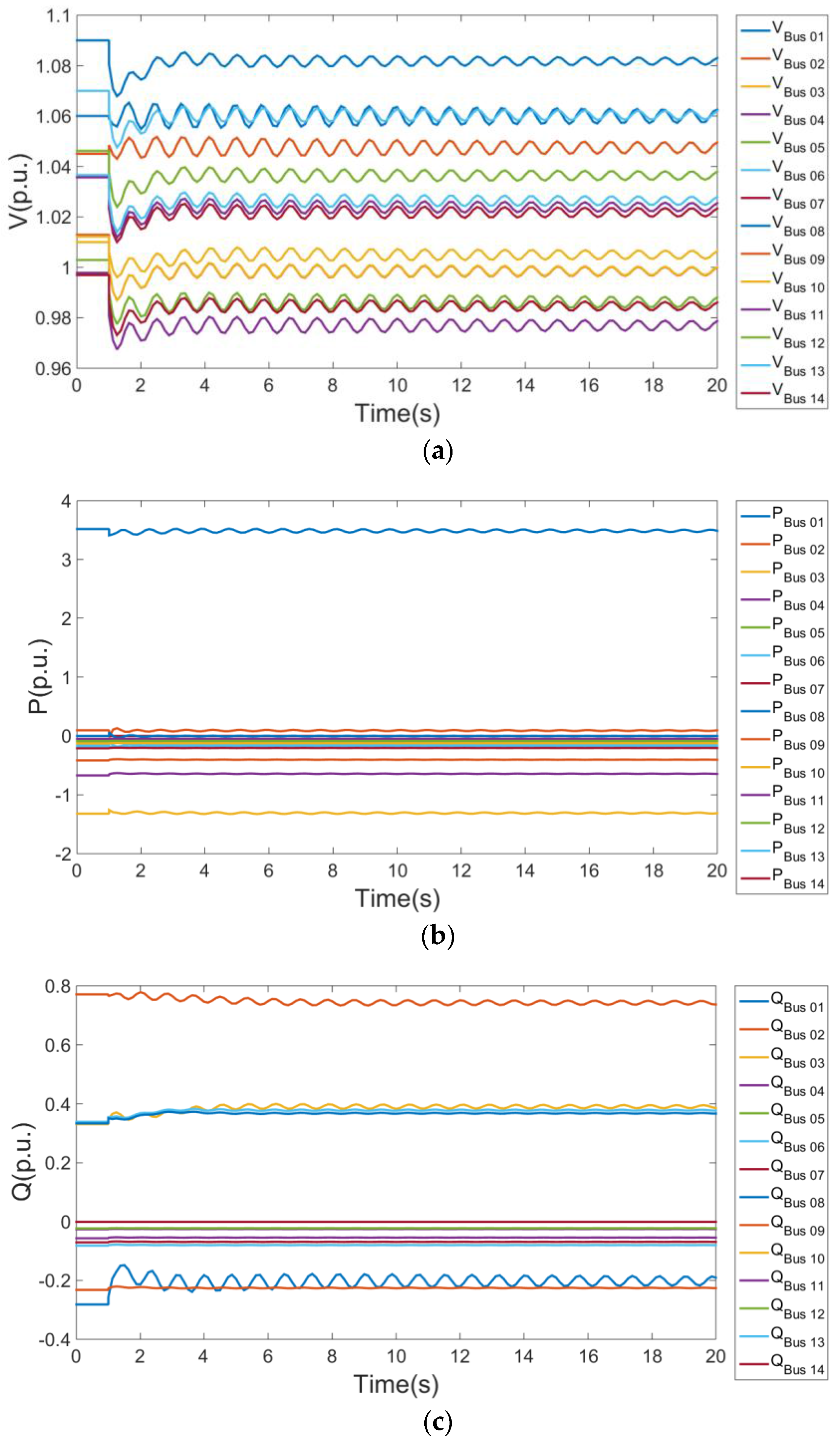
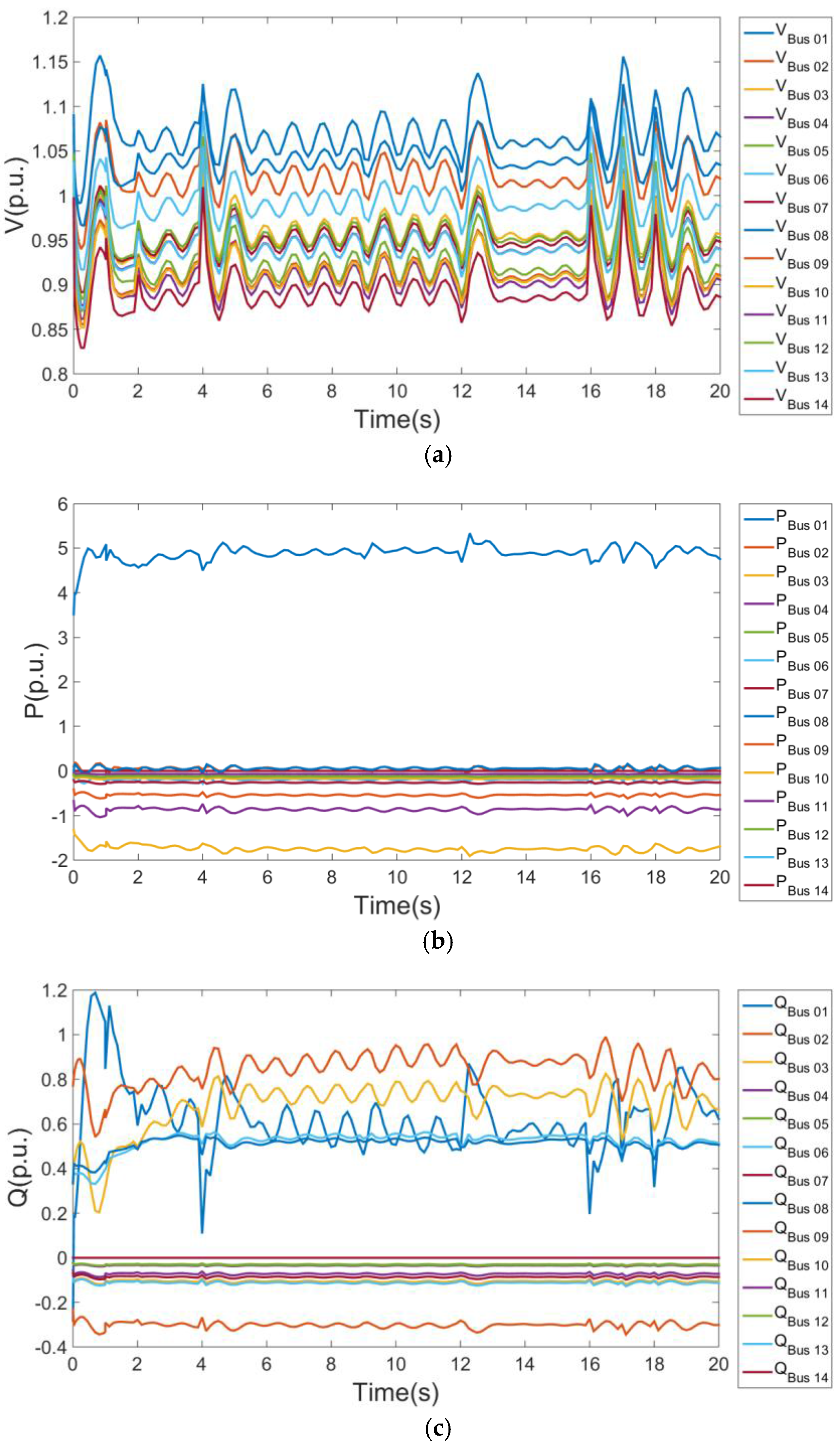
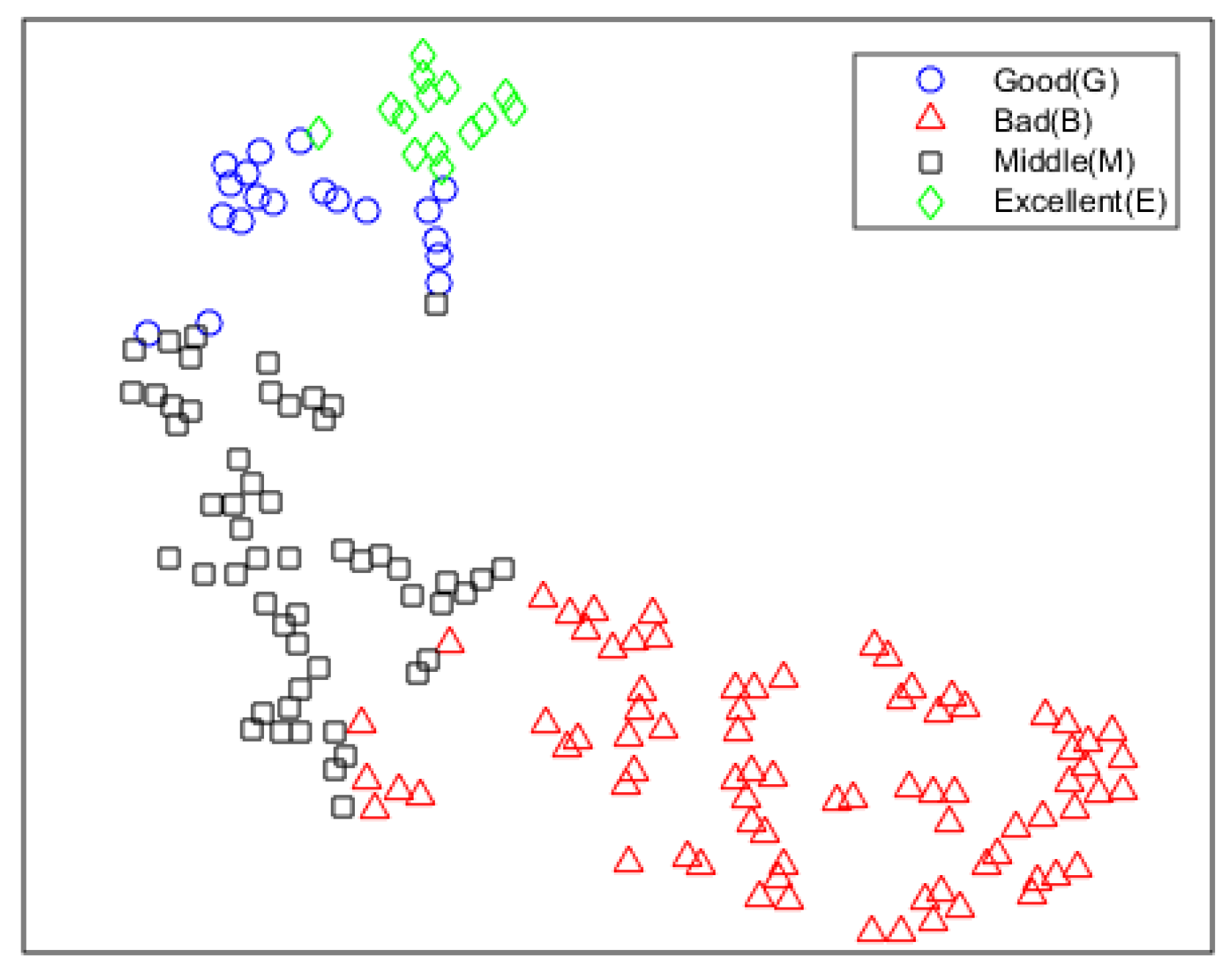

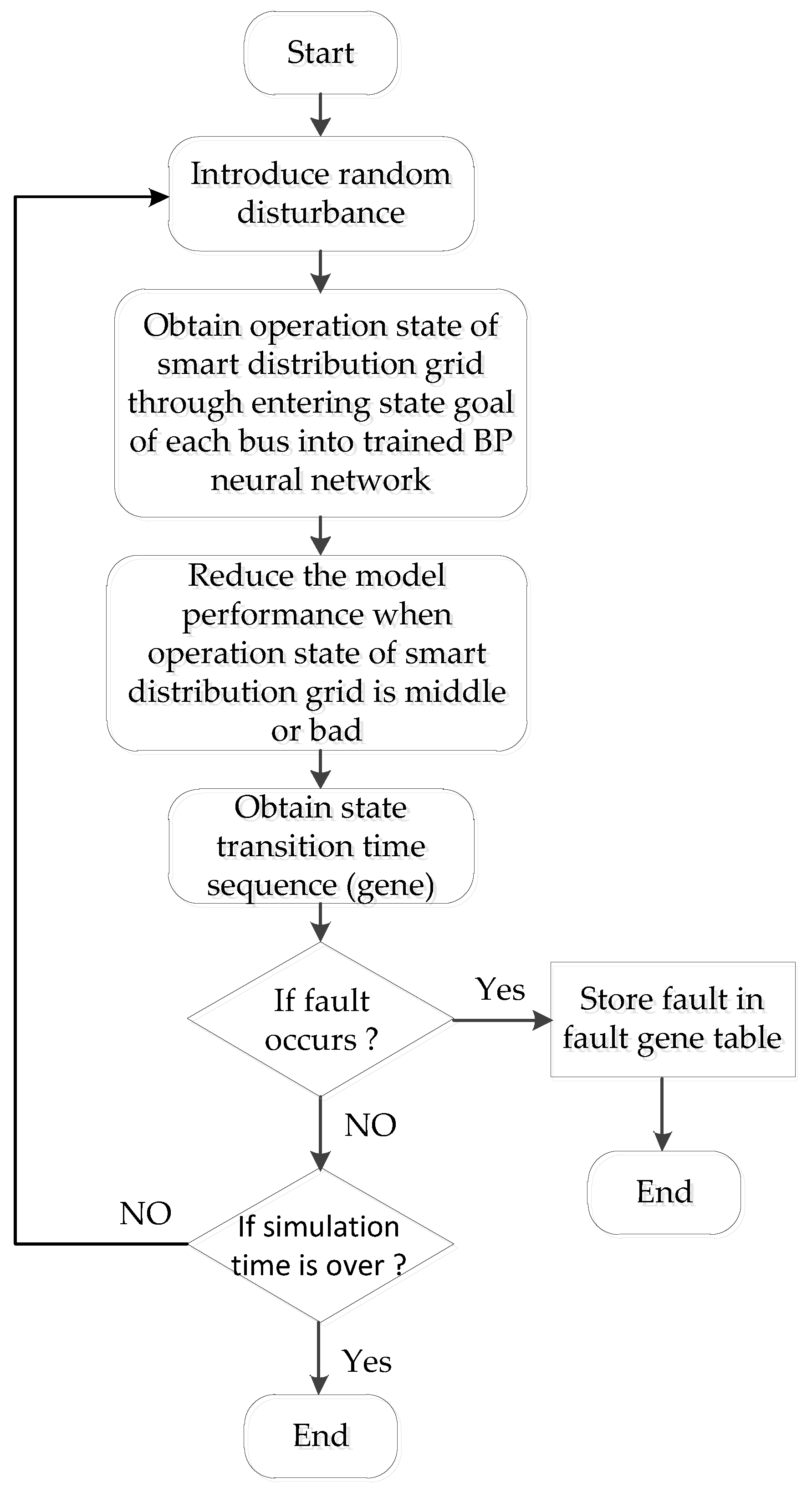
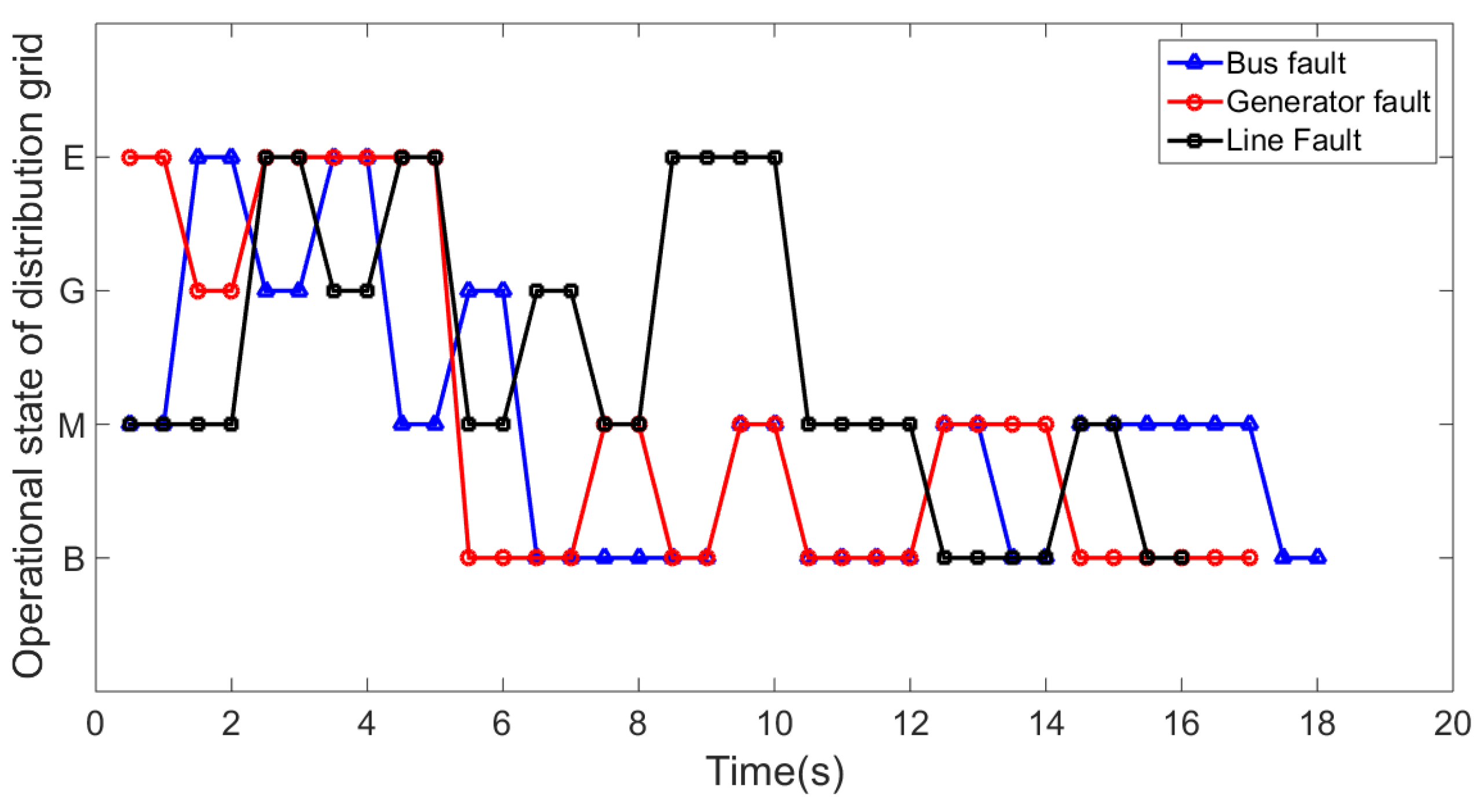
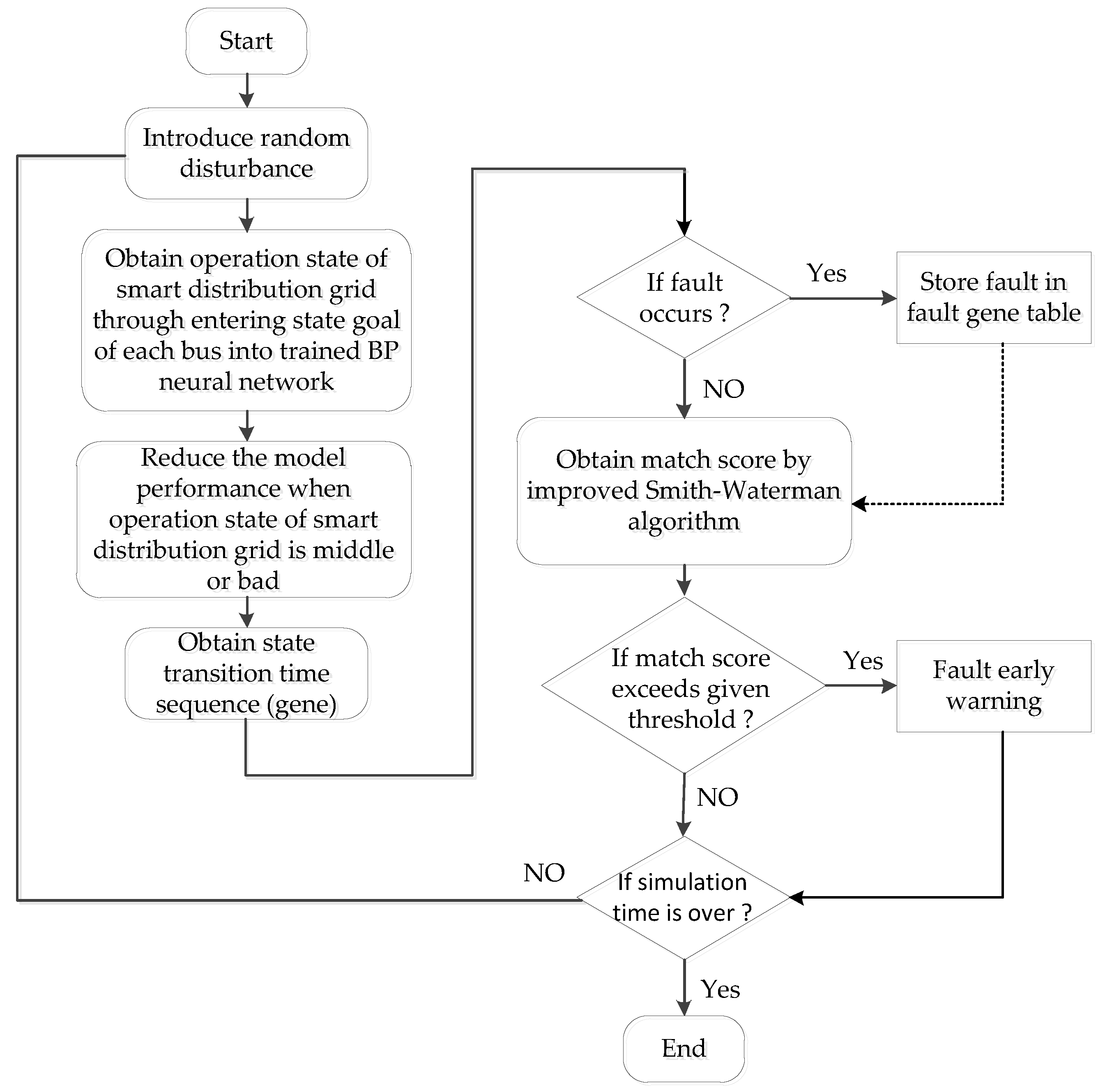
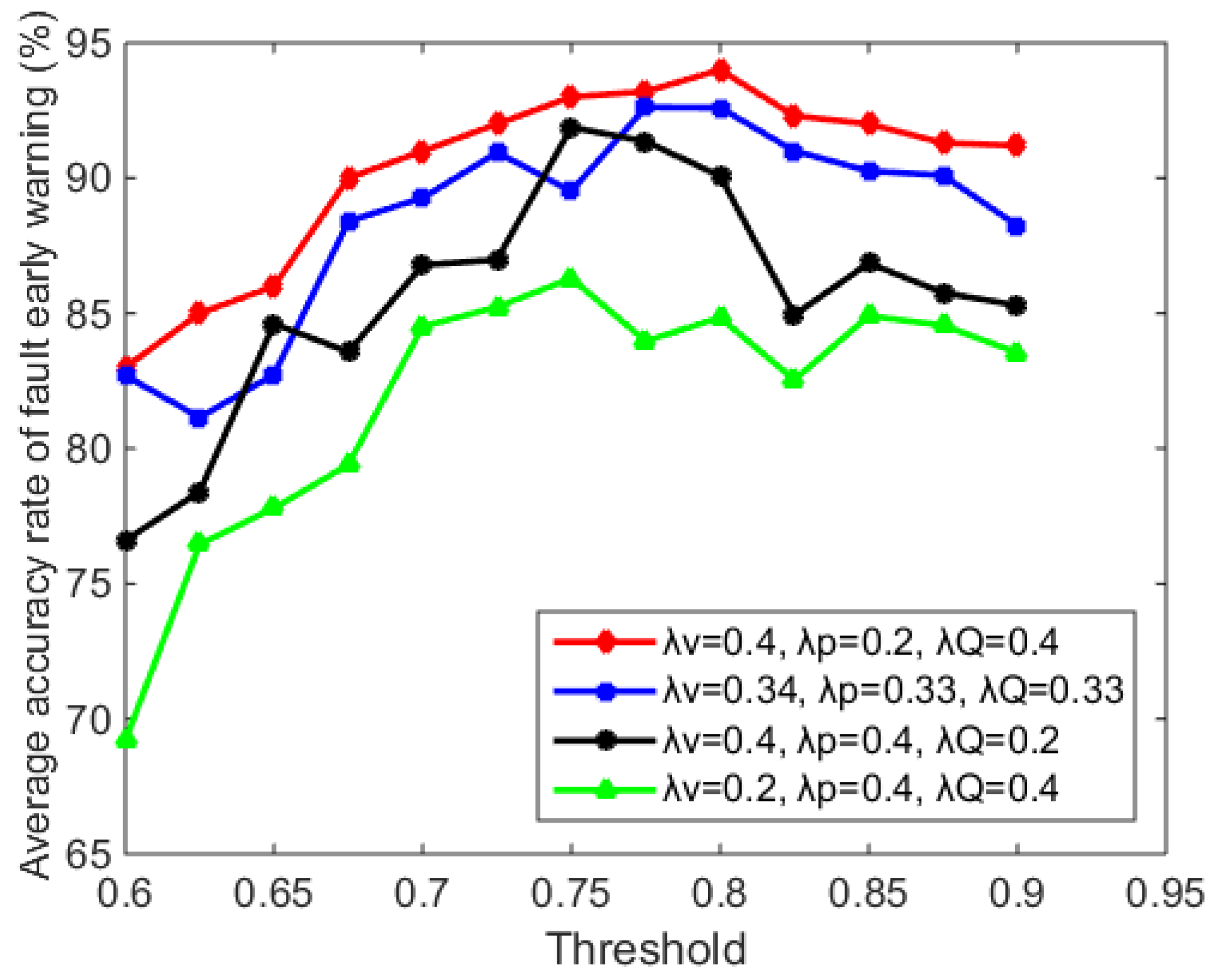
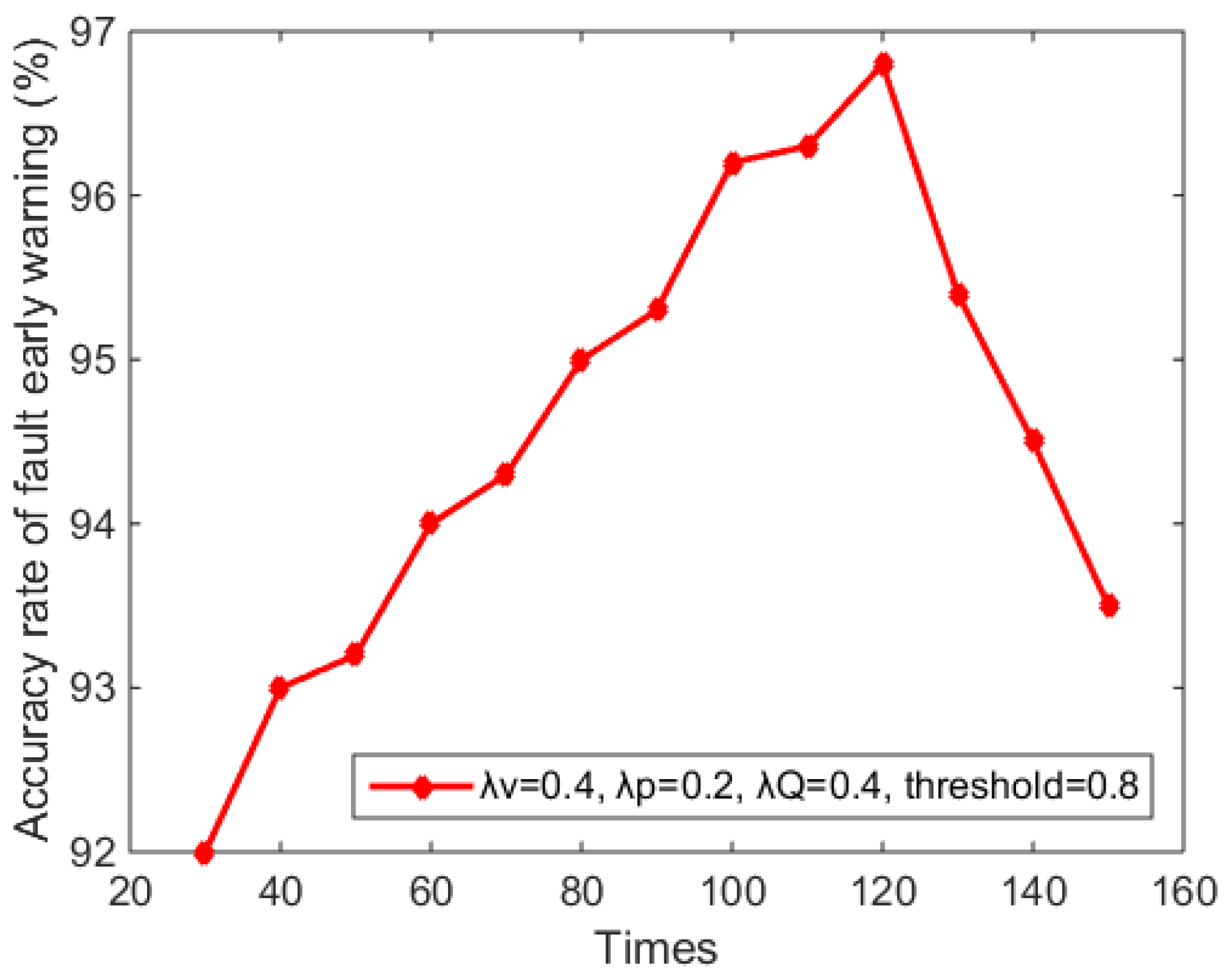
| Operational State | Excellent | Good | Middle | Bad |
|---|---|---|---|---|
| Label | E | G | M | B |
| Output | ||||
|---|---|---|---|---|
| State | Bad(B) | Middle(M) | Good(G) | Excellent(E) |
| Parameters | |||
|---|---|---|---|
| 1st set | 0.34 | 0.33 | 0.33 |
| 2nd set | 0.4 | 0.4 | 0.2 |
| 3rd set | 0.4 | 0.2 | 0.4 |
| 4th set | 0.2 | 0.4 | 0.4 |
| Parameters | Nodes of Input Layer | Nodes of Hidden Layer | Nodes of Output Layer | Learning Rate | Active Function |
|---|---|---|---|---|---|
| Value | 14 | [4,20] | 1 | 0.1 | sigmoid |
| Parameters | Warning Threshold |
|---|---|
| Value | [0.6, 0.9] |
| Parameters | ||||
|---|---|---|---|---|
| Value | 1 | 2 | 3 | 4 |
| Model | Bus | Line | Transformer | Synchronous Machine | PQ Load | AVR | Constant Voltage (PV) Generator | Breaker | Static Compensator |
|---|---|---|---|---|---|---|---|---|---|
| Number | 14 | 16 | 4 | 5 | 11 | 5 | 1 | 1 | 3 |
| Component Fault | Bus | Generator | Line | Breaker |
|---|---|---|---|---|
| Fault number | 60 | 50 | 100 | 40 |
| State | E | G | M | B |
|---|---|---|---|---|
| E | 1 | −1 | −2 | −3 |
| G | −1 | 4 | −1 | −2 |
| M | −2 | −1 | 9 | −1 |
| B | −3 | −2 | −1 | 16 |
| Model | Proposed Model | Based on Harmonic Current [13] | Fuzzy Logic Approach [14] | Bayesian Network [15] | Based on Short Circuit Current [16] | Fuzzy Comprehensive Evaluation and Bayes Discrimination [17] |
|---|---|---|---|---|---|---|
| Considered factors | All buses | harmonic current | Extreme weather | Affected components | short circuit current | Power transformer |
| Can it comprehensively consider the operational state | Yes | No | No | Yes | No | No |
| Is accuracy rate improved with the increase of times | Yes | No | No | No | No | No |
| Data sources | Simulation | Actual data | Simulation | Actual data | Simulation | Actual data |
| Verification means | Simulation | Actual Test | Simulation | Actual Test | Simulation | Actual Test |
| Result | Accuracy rate is close to 97% | Can detect the abnormal changes of the system harmonic current | Accuracy rate is 100% | Provide certain support degree for some faults | Can effectively predict the size of short circuit current | Can effectively discriminate the operational state of power transformer and warn early |
© 2017 by the authors. Licensee MDPI, Basel, Switzerland. This article is an open access article distributed under the terms and conditions of the Creative Commons Attribution (CC BY) license (http://creativecommons.org/licenses/by/4.0/).
Share and Cite
Xiang, M.; Min, J.; Wang, Z.; Gao, P. A Novel Fault Early Warning Model Based on Fault Gene Table for Smart Distribution Grids. Energies 2017, 10, 1963. https://doi.org/10.3390/en10121963
Xiang M, Min J, Wang Z, Gao P. A Novel Fault Early Warning Model Based on Fault Gene Table for Smart Distribution Grids. Energies. 2017; 10(12):1963. https://doi.org/10.3390/en10121963
Chicago/Turabian StyleXiang, Min, Jie Min, Zaiqian Wang, and Pan Gao. 2017. "A Novel Fault Early Warning Model Based on Fault Gene Table for Smart Distribution Grids" Energies 10, no. 12: 1963. https://doi.org/10.3390/en10121963





